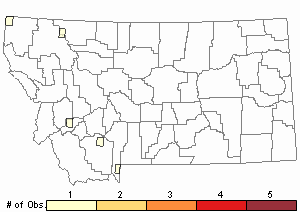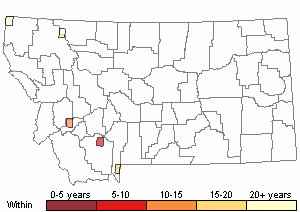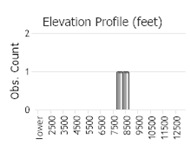View in other NatureServe Network Field Guides
NatureServe
Montana
Utah
Wyoming
Idaho
Wisconsin
British Columbia
South Carolina
Yukon
California
New York
A Dicranella Moss - Dicranella palustris
Other Names:
A Fork Moss
General Description
Plants: Acrocarpous. Growing in open clumps of erect shoots, somewhat glossy, pale green, sometimes with yellow tinges. Stems 2-11 cm tall (FNA 2007).
Leaves: Somewhat distantly spaced (FNA 2007), the base wide (Lawton 1971), suddenly narrowing to a slender, lance-shaped, subtubulose limb spreading ca 90 degrees, somewhat spiraled and undulate when dry, cupped when damp, 2.5-3 mm in length; apex slender, narrow and hood-like; base prominently extending down the stem; margins freely scalloped at the very far end of the apex (FNA 2007), smooth elsewhere (Lawton 1971); costa nearly reaching the apex, smooth on the dorsal face (FNA 2007).
Leaf Cells: Laminal cells smooth, not porose; upper laminal cells long (4-9:1), slender and quadrangular; basal laminal cells longer than the upper cells, quadrangular and very slender, yellow at the leaf attachment, frequently inflated in the lower basal angles (Crum & Anderson et al. 1981); costa in X-section with an abaxial stereid band and 2-3 guide cells (Lawton 1971).
Phenology
Fruit ripens in spring (FNA 2007).
Diagnostic Characteristics
Dicranella plants are similar to Dicranum species, but are not as large and have alar cells that are barely differentiated (FNA 2007).
Range Comments
North American Range
AK s to CA, AB and MT, ON to NL and NS, OH, NH and ME (FNA 2007). Known in Montana from Glacier and Lincoln Counties (Elliott 2016).
Observations in Montana Natural Heritage Program Database
Number of Observations: 5
(Click on the following maps and charts to see full sized version)
Map Help and Descriptions
Relative Density

Recency



 (Observations spanning multiple months or years are excluded from time charts)
(Observations spanning multiple months or years are excluded from time charts)
Habitat
Wet rock and soil (Elliott 2016), occasionally briefly inundated with water (FNA 2007), in watercourses and wet areas; frequently montane (Lawton 1971). Elevation: low to moderate (FNA 2007).
Reproductive Characteristics
Dioicous. Sporophytes infrequent (Lawton 1971). Male and female plants similar in size. Seta single, spiraled when dry, 10-30 mm tall, deep red, turning brown with age. Capsule bowed, only slightly tilted, 1-1.5 mm in length, smooth; peristome single, with 16 teeth, the teeth red, papillose and vertically lined, 2-lobed with the division reaching ca halfway down. Calyptra hood-like, concealing ca 1/2 of the capsule, falling away when the capsule ripens (FNA 2007).
Stewardship Responsibility
References
- Literature Cited AboveLegend:
 View Online Publication
View Online Publication Crum, H.A. and L.E. Anderson. 1981. Mosses of Eastern North America. 2 volumes. Columbia University Press, New York. 1328 pp.
Crum, H.A. and L.E. Anderson. 1981. Mosses of Eastern North America. 2 volumes. Columbia University Press, New York. 1328 pp. Elliott, J.C. and A.K. Pipp. 2018. A Checklist of Montana Mosses (1880-2018). Updated 3 January, 2020. Montana Natural Heritage Program, Helena, Montana. 73 pp.
Elliott, J.C. and A.K. Pipp. 2018. A Checklist of Montana Mosses (1880-2018). Updated 3 January, 2020. Montana Natural Heritage Program, Helena, Montana. 73 pp. Flora of North America Editorial Committee, eds. 2007. Flora of North America North of Mexico. Volume 27. Bryophytes: Mosses, Part 1. Oxford University Press, Inc., NY. xxi + 713 pp.
Flora of North America Editorial Committee, eds. 2007. Flora of North America North of Mexico. Volume 27. Bryophytes: Mosses, Part 1. Oxford University Press, Inc., NY. xxi + 713 pp. Lawton, E. 1971. Moss Flora of the Pacific Northwest. Hattori Botanical Laboratory. Japan: Yamabuki-cho, Shinjuku-ku, Tokyo. 362 pages plus appendices.
Lawton, E. 1971. Moss Flora of the Pacific Northwest. Hattori Botanical Laboratory. Japan: Yamabuki-cho, Shinjuku-ku, Tokyo. 362 pages plus appendices.
- Additional ReferencesLegend:
 View Online Publication
View Online Publication
Do you know of a citation we're missing? Elliot, J. C. 1993. Second checklist of Montana mosses. Unpublished report. U.S. Forest Service, Region 1. Missoula, MT. 45 pp.
Elliot, J. C. 1993. Second checklist of Montana mosses. Unpublished report. U.S. Forest Service, Region 1. Missoula, MT. 45 pp. Lawton, E. 1971. Keys for the Identification of the Mosses on the Pacific Northwest. Reprinted from 'Moss Flora of the Pacific Northwest'. Published as Supplement No. 2 of the Journal of the Hattori Botanical Laboratory. Nichinan, Miyazaki, Japan. 66 pp.
Lawton, E. 1971. Keys for the Identification of the Mosses on the Pacific Northwest. Reprinted from 'Moss Flora of the Pacific Northwest'. Published as Supplement No. 2 of the Journal of the Hattori Botanical Laboratory. Nichinan, Miyazaki, Japan. 66 pp. Malcolm, B., N. Malcolm, J. Shevock, and D. Norris. 2009. California Mosses. Nelson, New Zealand: Micro-Optics Press. 430 pp.
Malcolm, B., N. Malcolm, J. Shevock, and D. Norris. 2009. California Mosses. Nelson, New Zealand: Micro-Optics Press. 430 pp. Smith, A.J.E. 1980. The Moss Flora of Britain and Ireland. Cambridge University Press, Cambridge. 705 pp.
Smith, A.J.E. 1980. The Moss Flora of Britain and Ireland. Cambridge University Press, Cambridge. 705 pp.
- Web Search Engines for Articles on "A Dicranella Moss"





